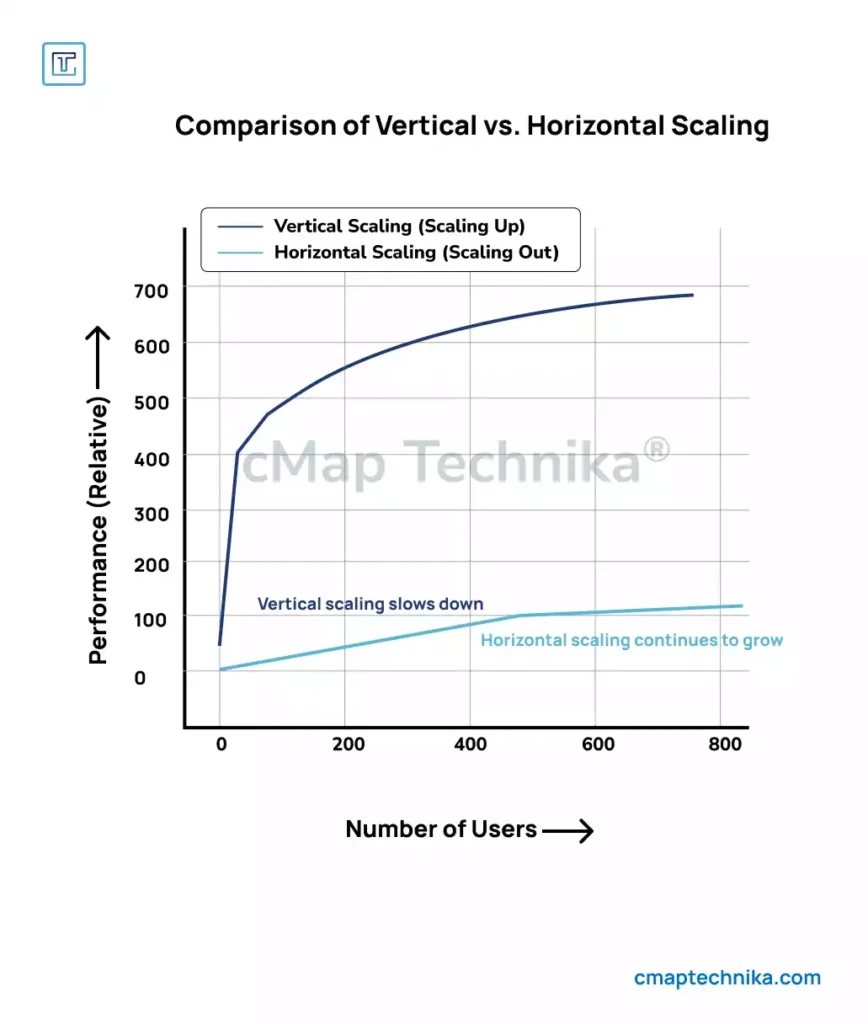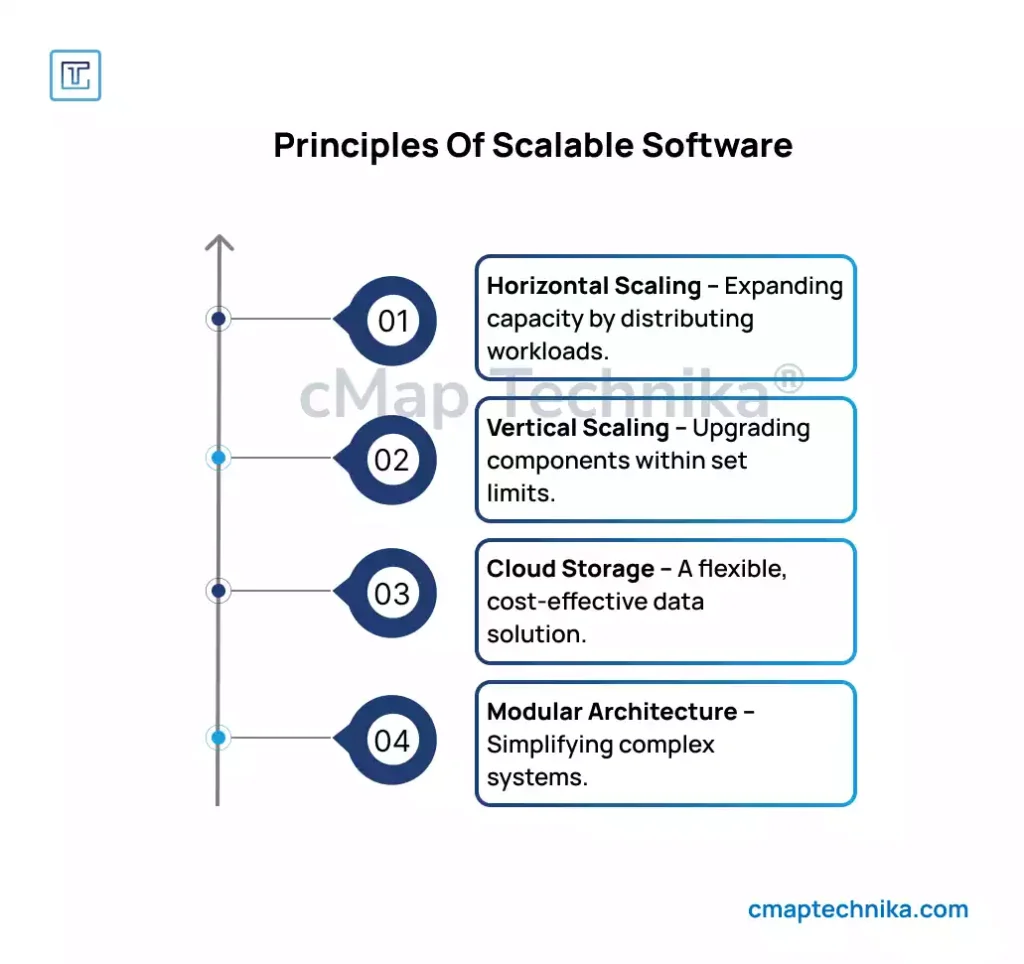Introduction
In today’s digital landscape, software is the backbone of businesses, powering everything from customer interactions to internal operations. But as companies grow, so do the demands on their systems. What works efficiently for a hundred users may crumble under the weight of a million. Without a scalable foundation, businesses face sluggish performance, frequent crashes, and expensive infrastructure overhauls—challenges that can stifle innovation and derail growth.
Scalability isn’t just about handling more traffic; it’s about maintaining seamless performance, optimizing resource allocation, and ensuring long-term adaptability. A well-architected system grows alongside the business, absorbing increasing workloads without compromising speed, reliability, or security. Whether you’re a startup looking to future-proof your technology or an established enterprise optimizing for efficiency, designing for scalability is a strategic imperative.
This guide explores the key principles of scalable software architecture, offering practical insights and industry best practices to help you build systems that not only withstand growth but thrive on it.
What is Scalability in Software Development?
Scalability refers to a system’s ability to handle increased workloads efficiently by expanding its resources. It ensures that as demand rises, the system remains performant without requiring a complete redesign.
There are two main types of scalability:

- Vertical Scalability (Scaling Up): This approach involves adding more power (CPU, RAM, storage) to an existing server. While it provides immediate performance improvements, it has limitations in terms of cost and capacity.
- Horizontal Scalability (Scaling Out): This method involves adding more machines or instances to distribute the load. It is generally more flexible and cost-efficient in the long run, as it allows for dynamic adjustments based on demand.
A well-designed system often combines both approaches to maintain efficiency and cost-effectiveness.
Principles of Scalable Software Design

1. Modular Architecture
A monolithic application can become a bottleneck as traffic increases. Instead, designing with a modular or microservices architecture allows different components to scale independently. This ensures better fault tolerance and facilitates easier updates.
- Microservices: Each service is designed to handle a specific function and can scale independently. This means that if one service experiences high demand, it can be scaled separately without affecting the entire system.
- API-First Approach: RESTful or GraphQL APIs enable seamless communication between services and external applications, promoting interoperability and flexibility.
- Containerization: Using Docker and Kubernetes to deploy microservices ensures consistency across development, testing, and production environments. Containers allow applications to run in isolated environments, making scaling smoother.
2. Efficient Database Design
A poorly designed database is one of the biggest scalability blockers. As data volume grows, the database must be optimized to handle increased queries efficiently.
- Database Sharding: Splitting large databases into smaller, more manageable pieces to distribute the load effectively. Each shard operates as an independent database, reducing bottlenecks.
- Replication: Creating read replicas to balance database queries and improve response times. This ensures that heavy read operations do not overwhelm a single database instance.
- Caching Strategies: Implementing caching solutions like Redis or Memcached helps store frequently accessed data, reducing database load and improving speed.
- Indexing: Optimizing search queries by properly indexing columns used in WHERE clauses. This enhances data retrieval speed and reduces query execution time.
3. Load Balancing and Auto-Scaling
To prevent server overload, implementing a load balancer ensures that traffic is evenly distributed across multiple servers, optimizing resource utilization and maintaining performance.
- Round-Robin Load Balancing: Requests are distributed sequentially among servers, ensuring even workload distribution.
- Least Connections Load Balancing: Directs requests to the server with the least active connections, preventing overload on any single machine.
- Auto-Scaling Groups: Cloud platforms like AWS Auto Scaling and Google Cloud Instance Groups automatically scale resources up or down based on real-time traffic, ensuring cost efficiency.
4. Asynchronous Processing & Event-Driven Architecture
Scalable applications reduce bottlenecks by executing tasks asynchronously, allowing non-critical processes to be handled in the background.
- Message Queues: Technologies like Kafka, RabbitMQ, and AWS SQS manage background jobs efficiently, ensuring smooth execution of processes without blocking user interactions.
- Serverless Computing: Running event-driven functions on AWS Lambda or Google Cloud Functions allows businesses to execute code only when needed, optimizing resource usage.
- Batch Processing: Instead of processing large datasets all at once, batch processing breaks tasks into smaller chunks, preventing system overload.
5. Optimized Code and Performance Monitoring
Writing efficient code and continuously monitoring performance are essential for maintaining scalability.
- Profiling and Load Testing: Using tools like Apache JMeter, Locust, or New Relic helps measure application performance and identify bottlenecks.
- Code Efficiency: Writing optimized, clean code reduces CPU cycles and memory consumption, improving overall efficiency.
- Observability: Implementing logging and monitoring with Prometheus, Grafana, or the ELK stack provides insights into system health and performance.
Choosing the Right Tech Stack for Scalability

The right technology stack plays a crucial role in scalability. Consider:
- Backend: Node.js, Go, Java, or Python (Django, Flask, or FastAPI) for scalable server-side processing.
- Frontend: React, Angular, or Vue.js with optimized rendering strategies to reduce client-side load.
- Database: PostgreSQL, MongoDB, Cassandra, or DynamoDB, depending on read/write requirements.
- Cloud Services: AWS, Google Cloud, or Azure, with built-in auto-scaling capabilities.
Scaling in the Cloud vs. On-Premises
While on-premises solutions offer full control, cloud platforms provide flexible scaling options with pay-as-you-go pricing models. Key considerations include:
- Cloud-Native Scalability: Kubernetes, Docker Swarm, and serverless computing allow businesses to scale seamlessly.
- Hybrid Cloud Solutions: Combining on-premises and cloud resources ensures maximum efficiency while maintaining security and compliance.
Future-Proofing Your Software
As technology and user demands evolve, software systems must be designed with longevity and adaptability in mind. Future-proofing ensures that your software remains scalable, secure, and efficient without requiring frequent overhauls. Here are three essential strategies to achieve this:
1. CI/CD Pipelines: Automating Deployment for Agility
Continuous Integration and Continuous Deployment (CI/CD) are essential for modern software development, allowing teams to push updates rapidly and reliably. By automating testing and deployment, CI/CD pipelines help maintain software stability while enabling fast iterations.
- Continuous Integration (CI): Developers frequently merge their code into a shared repository (e.g., GitHub, GitLab), where automated tests run to catch bugs early.
- Continuous Deployment (CD): Once the code passes all tests, it is automatically deployed to production without manual intervention.
- Tools: Jenkins, GitHub Actions, and GitLab CI/CD are popular choices for setting up CI/CD workflows.
- Benefits: Reduces deployment risks, minimizes downtime, and accelerates feature releases.
2. AI-Driven Scaling: Predictive Resource Management
Instead of relying on manual adjustments, AI-powered scaling optimizes resource allocation by analyzing historical usage patterns and predicting future demand.
- Machine Learning Models: AI analyzes metrics like user traffic, CPU/memory usage, and workload spikes to auto-scale infrastructure accordingly.
- Cloud Integration: Cloud platforms like AWS Auto Scaling and Google Cloud AI-powered scaling allow real-time infrastructure adjustments based on predictive analytics.
- Cost Optimization: By dynamically scaling resources, businesses prevent over-provisioning (wasting resources) and under-provisioning (causing performance issues).
- Example: An e-commerce platform can use AI-driven scaling to anticipate holiday traffic surges and allocate additional server instances before demand spikes.
3. Security Considerations: Strengthening Software Against Future Threats
With cyber threats evolving rapidly, future-proof software must incorporate robust security measures to protect against breaches and data leaks.
- Zero-Trust Architecture (ZTA): This security model ensures that no user or device is inherently trusted, requiring authentication and authorization at every stage.
- End-to-End Encryption: Sensitive data should be encrypted in transit and at rest to prevent unauthorized access.
- Automated Security Patching: Regular updates and patches help protect against newly discovered vulnerabilities.
- Compliance & Regulations: Businesses must align with security standards like GDPR, HIPAA, and ISO 27001 to maintain trust and avoid penalties.
By integrating CI/CD pipelines, AI-driven scaling, and robust security measures, businesses can ensure that their software remains resilient, adaptable, and secure in the face of ever-changing technological and market conditions. Future-proofing today means preventing costly migrations and performance bottlenecks tomorrow.
Conclusion
Building scalable software is essential for businesses aiming for sustained growth. By adopting modular architecture, efficient database management, load balancing, asynchronous processing, and cloud scalability, companies can ensure that their software scales seamlessly with their evolving needs. Investing in the right technologies and best practices today will save businesses from costly migrations and overhauls in the future.
As you embark on designing for scalability, consider measuring, monitoring, and iterating to keep your systems optimized. The future of software is dynamic—ensure that your infrastructure is built to handle whatever comes next.
Is your business software ready to scale? Let Waltcorp help you design a robust, future-proof architecture tailored to your growth needs.







